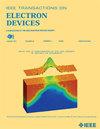Radiation Degradation and Mitigation of an Ultrathin SOI SPAD Using a Perimeter Gate
IF 2.9
2区 工程技术
Q2 ENGINEERING, ELECTRICAL & ELECTRONIC
引用次数: 0
Abstract
This work investigates the robustness of an ultrathin backside-illuminated (BSI) silicon-on-insulator (SOI) single-photon avalanche diode (SPAD) against gamma-ray irradiation for space applications. Experimental results demonstrate a breakdown voltage shift in the studied SPAD from 10.17 to 9.95 V after a total ionizing dose (TID) of 132 krad(Si). An increase in dark count rate (DCR) from 1490 to 2700 cps/使用周界栅极的超薄SOI SPAD的辐射衰减与抑制
这项工作研究了超薄背照式(BSI)绝缘体上硅(SOI)单光子雪崩二极管(SPAD)在空间应用中抗伽马射线辐射的稳健性。实验结果表明,当总电离剂量(TID)为132 krad(Si)时,SPAD的击穿电压从10.17 V转移到9.95 V。在此剂量下,在1 V的过量偏置下,暗计数率(DCR)从1490增加到2700 cps/ $\mu $ m2。TCAD模拟解释了氧化捕获电荷在SPAD性能上的作用,这些电荷是由活跃区域周围绝缘层的辐照引起的。这些被捕获的电荷移动峰值电场,导致过早击穿,而受冲击电离影响的活性区域的扩展增加了DCR。进一步的模拟表明,实现周长门控结构和减少氧化物厚度可以有效地缓解这些影响,通过利用电容效应,防止击穿电压漂移。周界栅(PG)将辐照后的模拟DCR从2700降低到1365 cps/ $\mu $ m2,从而增强了超薄SOI spad的辐射弹性,其TID超过132 krad(Si)。
本文章由计算机程序翻译,如有差异,请以英文原文为准。
求助全文
约1分钟内获得全文
求助全文
来源期刊

IEEE Transactions on Electron Devices
工程技术-工程:电子与电气
CiteScore
5.80
自引率
16.10%
发文量
937
审稿时长
3.8 months
期刊介绍:
IEEE Transactions on Electron Devices publishes original and significant contributions relating to the theory, modeling, design, performance and reliability of electron and ion integrated circuit devices and interconnects, involving insulators, metals, organic materials, micro-plasmas, semiconductors, quantum-effect structures, vacuum devices, and emerging materials with applications in bioelectronics, biomedical electronics, computation, communications, displays, microelectromechanics, imaging, micro-actuators, nanoelectronics, optoelectronics, photovoltaics, power ICs and micro-sensors. Tutorial and review papers on these subjects are also published and occasional special issues appear to present a collection of papers which treat particular areas in more depth and breadth.
 求助内容:
求助内容: 应助结果提醒方式:
应助结果提醒方式:


